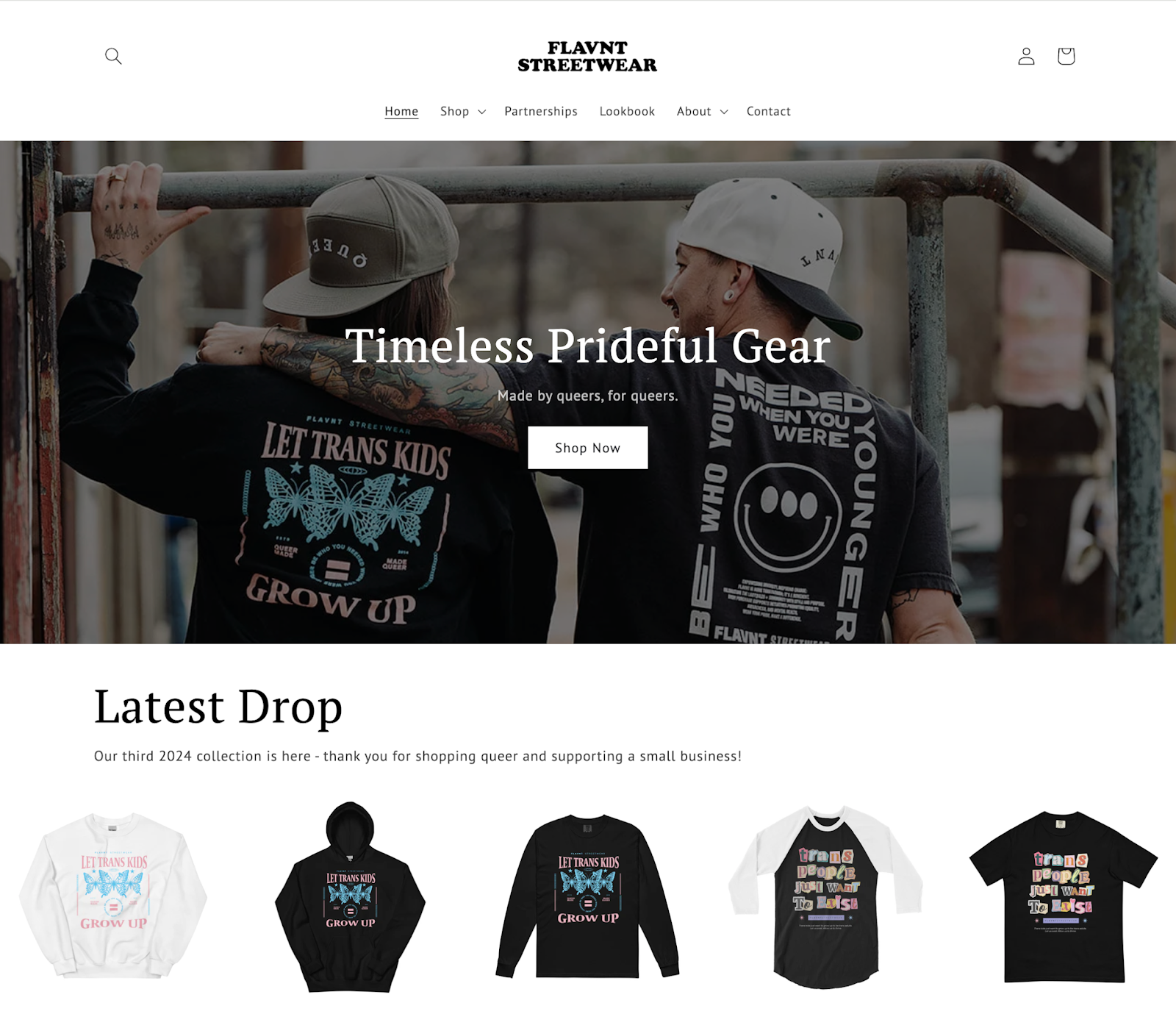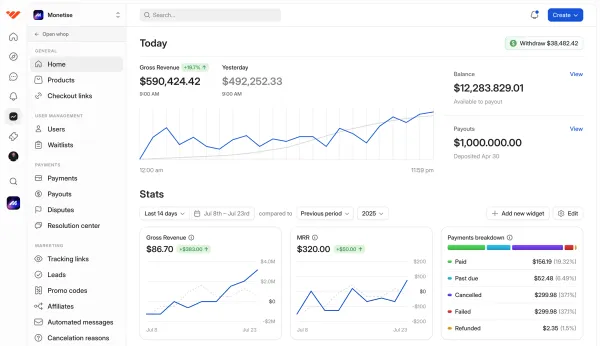Create a business plan that drives success! This guide breaks down each step, offering insights to refine your goals, uncover market gaps, and grow your brand.
If you're thinking of starting a new business or looking for ways to rocket your brand's current potential, having a strong business plan is essential.
From giving you clarity on your business goals to identifying potential gaps in the market, a solid business plan might be what you need to take your business to the next level.
Whether you're in the very first steps of building your venture or many months down the line, this guide will give you the tools to write a business plan that conquers!
What is a business plan?

A business plan is a document that provides a complete overview of what your business does, who it serves, how it makes money, and your strategy for doing so. Writing a business plan isn't just a document for potential investors — it’s an internal tool to help you clarify the vision of your business.
You'll be pleased to hear that business plans are not set in stone. It's completely natural for them to change over time. This might be because your strategy changes according to the needs of your target market or a change in company structure.
As your business grows, your business plan will too — many well-established companies revisit their business plan every few years to see how they've developed and find new opportunities.
Regardless of whether you're at the very beginning of your entrepreneurial journey or a few steps along in your business, having a solid understanding of your business plan is super important for your direction and tracking.
What are the benefits of creating a business plan?
Often we don't notice new opportunities or potential gaps in our business ideas until we have something right in front of us to go through. This is where your business plan comes in.
Detailing exactly what your business plans to sell, who to target, and how it operates can give a huge amount of clarity. Once you have a business plan in front of you, you'll be able to identify potential weaknesses and fill gaps in your planning before they develop.
Ultimately, a business plan is the roadmap for your success. This document also helps to make the decision-making process a lot easier, since you'll already be clued up on opportunities, your target market, and financial projections.
The key elements of a business plan
Putting a business plan together is no mean feat. Knowing the key components can make your life a lot easier and help you break down each section into manageable chunks.
Whether you're just running over a business idea or have the bare bones of your business plan together, this guide will support you in creating a roadmap to success.
Here are the key components of a business plan:
- Executive summary: This is a brief overview of your entire plan.
- Company description: What your business does and why it's different.
- Market analysis: Thorough research on your industry overall, target market, and competitors.
- Organization and management: The structure behind your business and how it plans to run.
- Products or services: What are you selling and its benefits to customers.
- Customer segmentation: A breakdown of your target market into relevant groups.
- Marketing and sales strategy: How you plan on promoting your business and making sales.
- Logistics and operations: A general overview of your business idea and how it's going to run.
- Financial projections: An overall report of your projected income, expenses, and funding requirements.
Much like writing a paper in college, there's nothing worse than staring at a blank document hoping that words will fill the page. Make a start by outlining the key elements above and conquer each section accordingly.
While you may have your business idea lodged in your mind, there is a method to crafting a powerful business plan. For example, your executive summary may be the first on the list but it's often easier to create it last.
Now, let's dive into how to create a business plan step-by-step.
Our step-by-step guide to creating a business plan
Now that you know what a business plan is and the main benefits of creating one, let's get stuck into how to create one.
1. Draft your executive summary
Think of your executive summary as an introduction to your business and your overall business plan. Since you're going to go into things with greater detail across the key elements of your plan, don't get too carried away here.
Often it's easier to get started with the next section of your business plan and return to your executive summary a little later. Nevertheless, this section should take the reader through the following:
What your business does
Before someone gets stuck into the nitty gritty of your business plan, they need to be able to see an overview of what your business does.
With plenty of details laid out later on in your business plan, this section gives you the opportunity to state the entire basis of your venture. If this section falls short, potential investors or lenders might stop here. So let's take a look at how to capture their attention and persuade them to continue reading and potentially invest.
Not sure what to include? We've got you covered:
Business concept
What does your business do? Use this immediate interaction with your business plan to hook your reader in. Talk about what your business does, why you do it, and your ethos.
Business goals and vision
What are you looking to accomplish? While you don't necessarily need the next 10 years of your business mapped out immediately, the reader needs to know what you plan to achieve. Where do you see the business going? How do you plan on running it?
Product descriptions and how you differ
What does your business sell, and what do you do differently? Now's the time to discuss your product (or services) and how you plan to stand out from the crowd.
Target market

Understanding your target market is crucial to knowing a wide range of things associated with your business plan, including price points, where you plan to sell, and how you stand out from competitors.
Talk here about who you plan on selling to, why they will buy into your product, and touch upon market research. If there's a gap in the market, how do you plan on filling it successfully?
Marketing strategy
Now that you've talked about who your customers are and why they need you, how do you plan on reaching them? Talk about your marketing and sales strategy, and how you plan on making the most of different channels to reach your customers.
Current financial situation
If your business is already up and running, what are you currently earning? Remember, you need to be honest here — don't go bigging up the numbers.
What you're looking for
Looking for investment? Your reader needs to know here what you're looking for. You can break down how you plan to use their investment later on, but feel free to touch upon it here if you prefer to justify your investment needs.
Our top tips for writing a powerful executive summary
What you include in your executive summary is just as important as how it's written.
If you waffle on, investors are going to get sidetracked before they even get into the depths of your business idea, financial projections, or market research. Here are our top tips for making your summary an impactful one:
Be concise
Your executive summary is just that — a summary of your business plan. You'll likely have many revisions of this section as you write your business plan, and that's okay.
Many people find it best to return to this section after completing the rest to summarize everything they've said throughout. Go through your business plan at the end and pick out key elements. Make a few bullet points and check over your executive summary to ensure it remains concise.
Remember, these are the highlights. Don't try to add everything into this section, you've got the rest of your business plan for further details.
Use bullet points
- Short sentences and bullet points can help to make your summary easier to read and skim.
- By breaking up your copy, extra whitespace alone can make your business plan easier to digest.
- Let's face it — your business plan is going to end up being a hefty document, so readers are likely to skim wherever they can.
Think about who you're writing for
While you may be writing a business plan for your own use, you need to think about who will be reading it if you are looking to take it to investors. Look for ways to personalize your summary — this will help you connect on their level and capture their attention.
Here are some ways to personalize it:
- In the form of a name in the salutation
- Share details in a way that resonates with the reader
- Think about the industry and its formalities — while your business plan will overall have a formal tone, some industries may adopt creativity or specific language/terms
Showcase your strengths
Why is your business unique? The answer to this alone can make your business capture the reader's attention. Highlight these strengths from the very start of your business plan.
Test your executive summary
When you know your business idea inside out, it's easy to assume that your summary makes sense to everyone. Instead, get a test reader with limited knowledge of your business and industry to give it a read-over.
It's super important that your business plan is clear to anyone who reads it. It could be worth having a variety of test readers available to identify any confusing language or misleading statements.
2. Write a company description

If you're looking for investment, investors need to understand clearly what you do, what you sell, and who is managing the company. You can even include a little note on your founders or executive team here as well to give insight into those behind the brand.
Investors need to know why you're a good investment and that you've considered all angles of your business plan, from operations to your sales and marketing strategy.
Don't get carried away listing previous experience or current work; this isn't a CV.
Put simply, this section should answer two important questions:
- Who are you?
- What do you plan to do?
If you're stuck for words, try taking a look around the websites of big brands. For example, TOMS uses its About page to highlight its mission to create a positive impact with its 'One for One' model.

Even if you're not pitching to potential investors, having these details mapped can still be very helpful. This section is where you can talk about your brand's principles, ideals, and mission.
Here are a few components to consider including in your company description:
- How your business is structured (sole proprietorship, general, limited partnership, or incorporated company)
- Your business model
- What industry you're in
- Your vision, mission statement, and value proposition
- Some background information on your business
- Both short- and long-term business objectives
- Your key team members
Unsure of the legal structure of your business? We break down what an LLC (or Limited Liability Company) really is in our step-by-step guide.
Your brand values and goals
It's easy to get caught up when working out your brand values. It's even easier to try and explore how others portray their businesses and believe their core values are exactly the same.
To determine a set of your own, think about the relationships your business has and how you build rapport with them. From customers to suppliers, employees to investors — how do you conduct business? As you make a list, your core values will start to come out on their own.
As well as an overview of your company, your company description should also include both short- and long-term goals. Here's a quick summary of the two:
- Short-term: Achievable in the next year
- Long-term: Achievable in one to five years
Remember, your goals need to be SMART: Specific, measurable, attainable, realistic, and time-bound.
Vision and mission statement
Once you've got your brand values in the bank, writing a mission statement becomes a lot easier. Your mission statement should explain why your company exists (e.g., why it is needed). Keep it short and sweet — no more than a sentence.
Next, move on to your vision statement. What impact do you see your business having on the world if your vision were achieved? Approach this with confidence: "We will..."
Your vision statement needs to be just as concise as your mission — but it can be a little longer — aim for three sentences at the most.
3. Perform a market analysis
Whether you intend your business plan to go in front of investors or simply give yourself some clarity, performing a market analysis can provide crucial insights.
No matter what type of business you're running, whether a home-based business or service-based, knowing your market is key to your success.
Performing marketing analysis will help you to identify a need for your product or service and help you understand who needs it — and at what price. If you choose the wrong market or head into the market at the wrong time, you could see yourself struggling.
Skip the headaches and carry out thorough research beforehand. Your market analysis should include an overview of the market you're targeting, your current positioning, and an analysis of competitors.
What are the market opportunities?
Any investor is going to want to know how big your target market is and your income potential. While it's easy to get carried away with sky-high projections, it's important to include independent data to validate your estimated potential market.
Before you dive into your research, here are our top tips for starting the process:
- Understand your ideal customer: Dig deeper into where they live, what social media platforms they use, and their shopping habits.
- Research relevant industry trends: Explore consumer and product trends via Google Trends, influencers, and publications.
- Make informed guesses: Perfect information isn't always possible to find, but you can base your estimates on verifiable data.
SWOT analysis
If you haven't completed a SWOT analysis before now, don't worry. SWOT stands for strengths, weaknesses, opportunities, and threats. A SWOT analysis is a strategic tool to help you evaluate your business ideas, anticipate challenges, and improve upon existing business models.
This is often depicted in a grid or another visual way to make it easy to break down these four areas. When shown visually, your reader can quickly see any factors that may impact your business — to determine your competitive advantage in the market.
Competitive analysis
If your business plan has the intention of enticing investors, demonstrating clear competitive analysis can be the pathway to success. There are three key elements you can use to differentiate your business against competitors:
- Cost leadership: Are you able to offer a lower price point than your competitors? This could help to maximize profits and give you a competitive advantage.
- Differentiation: What are you offering that others aren't? Other brands might be in the same industry, but if you offer something unique you could become an industry leader.
- Segmentation: You might start by targeting a niche market, but once you build traction this could quickly expand — accelerating your profits. Keep this in mind and highlight it in your business plan.
It's not all about implementing an undercutting pricing strategy, although this is one potential route to take. Think about how your business stands out and how niching down could benefit your business idea in the long run.
One great example of successful segmentation is TomboyX, an underwear brand based in Seattle, Washington. Originally started as a t-shirt brand, TomboyX quickly noticed a gap in the market — underwear fit for any body. Yep, any type of body.
As TomboyX discovered its true audience, this company impressively tripled its revenue by focusing on a gap they were able to fill. Not only did they solve a problem, but their brand quickly resonated with customers.

To best understand where your business sits in your target market, you'll need to get to grips with your potential competitors. What are they doing well? What are they doing badly?
TomboyX recognized that people were looking for boxer briefs for all types of bodies but also in expansive sizing at the same price point.
Even with an innovative product, you'll have competition of some sort. This is why your competitive analysis is so important. If you're looking to enter an already-established market, list out a few direct competitors and explain why you're different. Investors will want to know how you plan to differentiate your business — and even if your business plan isn't for investment, you'll benefit from the clarity too.
It isn't all about exact product differentiation
If you're entering into a broad market that is difficult to stand out in, there are other ways to create competitive differentiation. For example, in the world of jewelry, it could be that you donate a portion of your profits to a notable charity.
Can't identify direct competitors?
No problem. If it's difficult to find direct competitors, try to look for indirect ones. This could be other brands that are selling a substitute for your product.
If your product is brand new and solves an otherwise unresolved problem, consider what customers are currently doing to solve that issue.
4. Outline the management and organization
Those reading your business plan will want to know how you plan on running your company. If investors are contemplating getting on board, they'll want a clear picture of how your business is set up.
Make sure to mention whether you'll incorporate your business as an S corporation, limited partnership, or sole proprietorship.
If you have a clear structure for your management team, show this in your business plan in an easy-to-follow chart. Readers will want to know the responsibilities of each member of your company's internal structure and how they will contribute to your business's success.
5. Talk about your products and services
Although your products or services will feature throughout your business plan, it's important to provide a section that is dedicated to what you offer.
If you sell a lot of different items, it won't be expected of you to include every single item in your business plan. If this is the case, provide a more general overview of your product lines.
For example, Flavnt Streetwear sells clothing, accessories, and binders. Their business plan would cover those categories and key information about the products within each.

If you've got plans for new products in the future, don't be afraid to include these in your business plan. Not only will this help show investors that you have ideas ahead of time, but it also demonstrates how you plan to increase profitability.
Don't forget to include how you plan to fulfill orders. Whether you plan to print t-shirts yourselves, use dropshipping, or find suppliers elsewhere.
On Whop, you can find an abundance of communities committed to helping you grow your side hustle. Learn how to dropship, design your brand, and much more — all from the Whop marketplace.
Thinking about launching an ecommerce business? Here's how to create a business plan for your big idea and stand out from the crowd.
6. Perform customer segmentation
Before we dive into your sales and marketing strategy, it's important to understand your target market fully. As we touched upon earlier, customer segmentation is key.
Including this customer profile in your business plan will show readers that you know exactly who you're targeting, as well as how you plan to speak to them in your marketing and sales plan.
To get to grips with your buyer persona — and make crucial marketing decisions — try to ask yourself the following:
- Where do they live?
- What is their age range?
- Where do they work?
- What is their spending capability?
- What is their level of education?
- What are some common behavior/lifestyle patterns?
- What do they do in their free time?
- What technology do they use?
- What are their values, beliefs, or opinions?
While this information will vary according to what you're selling, it's important to dig down into the specifics. This will show that your business plan is well-researched and that you know exactly who you're trying to target.
If you find yourself getting stuck, an easy way is to think of one person. You can even start by finding a stock image of that person, giving them a name, and then building out the buyer persona.
Narrowing down your customer profile in your business plan is an important step, and demonstrates your understanding of your target market. Let's say that your customer segmentation is based on 19-26 year old college students. This type of buyer persona would look very different from that of a 55-year-old who works in finance.
7. Define your marketing and sales strategy
Your marketing and sales plan is directly informed by the steps above. After all, how would you know what to add to your marketing strategy without knowing who you're targeting?
As you outline your marketing strategy in your business plan, remember to keep your ideal customer at the forefront of your decisions.
Let's say you're selling sneakers aimed at 20-somethings. It's unlikely you're going to capture their attention on the likes of LinkedIn. If you're incorporating a social media marketing strategy into your overall marketing efforts, explain why. If that's where your audience hangs out, great. But if not, you might want to rethink your strategy.
But it isn't just about targeting your customers on social media. A solid marketing plan will also include information on four key elements:
💰 Price: How much do your products cost, and how did you make that decision?
👕 Product: What are you selling and how do you differentiate yourself in the market?
🌟 Promotion: How do you plan on getting your products in front of your customers?
👩💻 Location: Where do you plan on selling your products? On what channels and in which markets?
For example, if you've already got your own website set up, mention this in your business plan. You can also include your strategy for SEO and marketing channels you have the most control over.
Starting a blog for example will help to reinforce your brand values and increase brand awareness. This can not only become a space to educate your customers on what you do but also provide insights into your industry and upcoming ventures.
A brand that does this well is Lick. Their blog goes above and beyond paint colors, offering insights into decor, design trends, and how-tos. This alone can help to build a brand voice for your business, creating your own community.
Highlighting this in your business plan shows that you've considered a variety of channels to promote your business.

8. Create a logistics and operations plan
Whether you're writing a business plan for your own planning purposes or to approach investors, logistics, and operations, bring your business idea to life.
No matter who you're writing a business plan for, this is a crucial section to include. Think about how you're going to fulfill orders and run your business overall.
In this part of your business plan, try to cover the following:
- Suppliers: Where will you source the materials you need for production, or where will your products be produced?
- Production: Are you planning to make your products yourself? From manufacturing to whole or dropshipping, detail how you plan on producing your products. You'll also need to include timelines here on how long it'll take to produce your products and have them shipped. This is especially important for managing a spike in demand or a busy season.
- Facilities: Where will those running the business work? If you need a physical retail space, where will this be?
- Equipment: To get your business up and running, what tools and technology will you need?
- Shipping and fulfillment: To fulfill orders, will you be handling this in-house or using a third party?
- Inventory: If you plan on stocking up before launch, where will stock be kept? Will this be shipped to partners?
Knowing how to write a business plan effectively will help secure funding — with logistics and operations playing a key role.
This section should signal to the reader that you have a strong understanding of how your business will run. Where possible, include contingency plans. If you sell a product that will likely see a spike in sales around Christmas for example, how do you plan to manage this?
Looking to start a business? Check out our blueprint to success and start turning your big ideas into a money-making business.
9. Make a financial plan

For any new business, talking about money can feel daunting. Regardless of how great your idea may be, potential investors will want to know the details of your business's financial health.
How much detail you go into here in your business plan may depend on your audience. If your business plan is for your own clarity, you may take a slightly different angle in providing financial projections.
However, if you aim to entice new business partners, you're going to want to include three major views of your financials:
- Income statements
- Balance sheets
- Cash flow statements
If you're seeking investment, including financial projections in your business plan could be beneficial. But don't get too carried away here. If you over-project, investors could be put off unrealistic goals with evidence to back them up.
Now, let's break down those three major elements:
Income statements
If your business is already up and running, providing income statements can help readers understand your revenue and expenses. Writing a business plan for your own clarification? No problem at all, including this information here can help you recognize that all-important bottom line.
Not launched yet? Use this space to project future strategic financial plans.
Balance sheets
A balance sheet is designed to give an overview of what your business owns (business assets) and what you may owe (any liabilities).
This simple sum looks a little like this: Assets - Liabilities = Equity
Balance sheets give the reader an indication of the value of your business. If you're running up debt, for example, this part of your business plan will help you recognize what you own and owe concisely.
Cash flow statements
Similar to your income statements, cash flow statements take into account when revenue is collected and expenses paid.
This is an important element of your business plan, especially for investors reading your business plan. After all, you want your incoming cash flow to be greater than your outgoings.
If your business isn't up and running just yet, forecast your cash flow statement to help identify any gaps or negative cash flow. This will show investors that you have covered all bases and adjusted your business operations accordingly.
Need a little help? Business plan creator apps can make this process easier.
Why write a business plan?
Knowing how to create a business plan correctly can not only give you real clarity on your own business but also provide a solid understanding to potential investors.
A well-crafted business plan highlights company plans and business goals overall and helps owners identify any areas of weakness.
Aside from applying for a business loan or seeking investment, there are several other reasons why you might write a business plan:
💡 To help you clarify ideas: Understand the scope of your business plans and clarify your business ideas, including the resources needed to get started.
📖 Strategic research: In order to write a business plan, you need to know exactly who your ideal customers and competitors are. A business plan allows you to carry out thorough research.
🙌 Partnerships: Planning on collaborating with other brands? Having a clear view of your new business will make it easier to identify other brands and explain why you make a good pairing.
💰 Investments and competitions: A winning business plan can help you to apply for grants, enter business competitions, and gain funding from investors.
The different types of business plans
Although we've shown you how to create a business plan with the above steps, there are different types of business plans to consider.
Business plans come in all shapes and sizes, depending on your goals. While some are incredibly detailed with graphs, reports, and forecasting, others can be very brief.
Let's take a closer look at the different types of business plans below.
Traditional business plan
The steps we've covered in this guide are the ones to take for writing your traditional business plan. This type of business plan is the most common and usually includes the most information.
When taking your business idea to capitalist firms and lenders, the level of detail in a traditional business plan would be expected. If you don't plan on seeking outside investment, you could opt for a lean business plan.
Lean business plan
Exactly what it says on the tin — a lean business plan is a shorter version of a traditional business plan. While it follows the same format, only the most important information is included.
If you're starting a new small business, a lean business plan can be incredibly helpful for your own clarity. Some business owners also use a lean version to onboard new hires or tweak their existing business plan for a new market.
Non-profit business plan
Very similar to a traditional business plan, a non-profit business plan includes all of the crucial information we've detailed above. However, since this type of business operates for public or social benefit, you will also need to detail the impact of your new non-profit business.
Business plans for non-profits may adopt a slightly different angle to your traditional business plan, since your intention is likely to gain donations, not investments.
How to create a business for a startup

If you're in the very first steps of your business, knowing how to create a business plan is crucial. While every business plan is unique, there are some things to keep in mind as a startup:
- Knowing your audience matters: Pay attention to who will be reading your business plans and the level of detail required.
- Have a clear goal in mind: If you're seeking funding, the aim of your business plan will be very different compared to writing a structured plan for your own clarification.
- Spend time researching: No matter who you're writing your business plan for, research matters. Look to independent sources for thorough research.
- Pay attention to consistency: To ensure the tone, style, and voice are consistent across your business plan, ensure your plan is managed by one person or reviewed thoroughly before distributing.
- Use a business plan template: Using a business plan template can give you the bare bones of your strategy, helping to guide you through each section.
Ready to present your business plans?
Now you know how to write a business plan, it's time to take your big ideas and present them. If you plan on seeking an investment, simply sending over a document might not be enough.
So if you've already conquered the market research, got your management and organization structure in place, and your financial forecasts to hand — let's get ready to present.
Breaking your presentation down can make it a lot less daunting. Remember, this information will be in your business plan. Let's break down the sections:
- Problem: What problem are you solving?
- Solution: How does your business address the issue?
- Market: Who is your target market?
- Competition: Who are your competitors? How do you differentiate?
- Business model: How will your business make money?
- Financial projections: How much money do you expect to make, and what are your outgoings?
- Team: Who is involved in the running of the business, and why?
Further tips for creating a business plan
Add any additional information to an appendix
If you have any supporting documents or additional materials you've referred to, or simply can't fit in, include these in an appendix. These might be:
- Relevant licenses and permits
- Patents
- Bank statements
- Financial projections in the form of graphs
- Equipment leases
- Contracts
- Details of business credit history
Don't over-project
Of course, you want your business plan and financial goals to look impressive, but it's important to avoid over-optimism. Whether you're going up in front of investors or applying for a bank loan, don't get too carried away with your financial projections.
Proofread your business plan carefully
If you make simple spelling, punctuation, or grammatical errors, your readers could quickly be put off.
After all, if your business plan is full of sloppy spelling, it would be easy to doubt whether other information is accurate.
Don't worry if writing and editing aren't your forte; look for a professional business plan writer, editor, or proofreader. There are plenty available on hiring platforms such as Bark and Upwork.
Level up your business with Whop
Knowing how to write a business plan is just the first step to business success. Once you've got your ideas and strategy aligned, now it's time to find the right platform to learn everything you need to build your new venture.
Whether you're taking baby steps with your brand or working on building an empire, the Whop business marketplace is your one-stop-shop for everything business. Learn how to market your business, reach new audiences, or even craft your copywriting skills — all from the Whop community.
With an abundance of business communities available, you'll never be short of new things to learn on Whop.
Sign up to Whop today in under 10 minutes and start learning.















